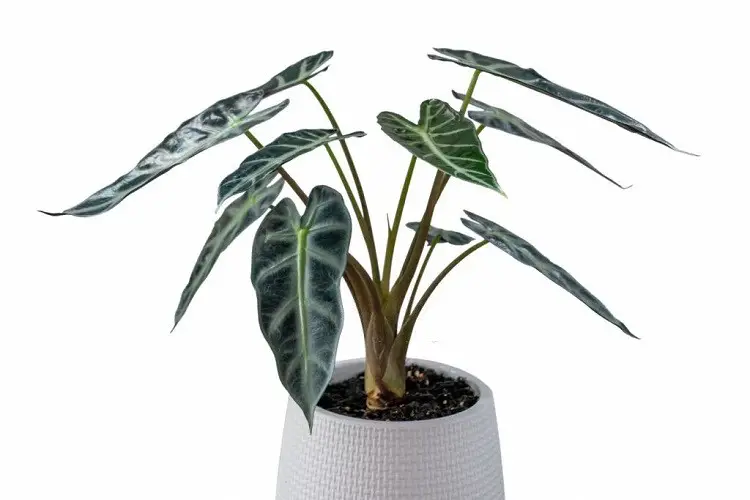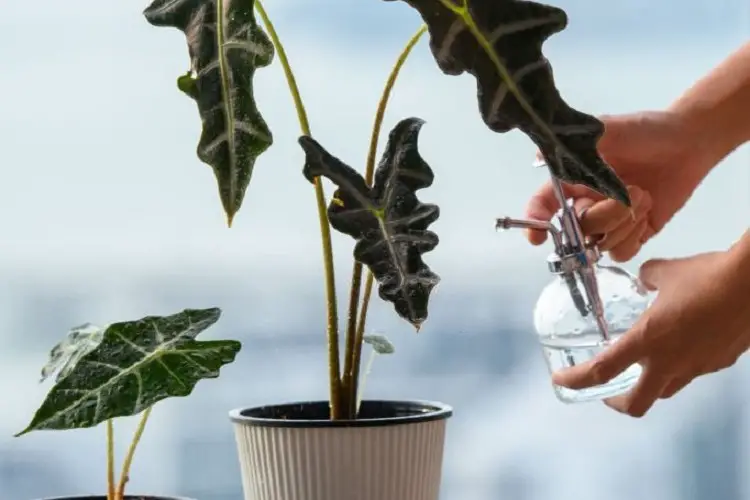If you are wondering how to care for Amazonica plant, don’t worry. We have got you covered.
The Amazonica plant is one plant most people would love to keep at home, but the issue is that if not well taken care of, there are lots of chances that it would die off.
Alocasia Amazonica, also known as Amazonica Polly or African mask, is a compact house plant from the elephant ear family. Its existence is a result of a hybrid crossing between two unverified parents.
It can be purchased, planted, and cared for all year round in an indoor environment.
Growing the plant is tedious, but it is very much achievable, and we will help you do that.
Here is a brief care tip on how to care for Amazonica plant
- Soil: Lightweight, well-draining potting mix.
- Light: Bright, indirect light. Avoid excessive direct sunlight.
- Temperature: 65-80°F/18-27°C. Below 60°F may trigger dormancy.
- Water: You must maintain evenly moist but not soggy soil during the growing season, watering when the surface begins to dry. Reduce watering significantly in winter.
- Humidity: Moderate to high humidity levels are required, ideally greater than 50% humidity.
- Fertilizer: Apply a balanced, water-soluble fertilizer every 2-4 weeks during the growing season. In the spring and autumn, dilute to half strength. During the winter, there is no need to fertilize. Every 2-3 months, flush the potting mix.
- Propagation: Carefully divide the rhizome when repotting in the spring period.
Amazonica Plant: All You Need To Know
Alocasia Amazonica, also known as Amazonica Polly or African mask, is a compact house plant from the elephant ear family. Its existence is a result of a hybrid crossing between two unverified parents.
It can be purchased, planted, and cared for all year round in an indoor environment. The plant’s broad leaves make the home welcoming, adding that nice tropical feeling to your home, hence the name Amazonica.
The plant exudes tropical foliage, but contrary to its name, its origin isn’t Amazon but tropical Southeast Asia.
It has deep green leaves that are roughly serrated, and in some cases, the leaf color appears as an almost purple-green, accentuated by whitish or light green veins.
The plant is blessed with quick growth, reaching a mature height of up to 2 feet. It rarely blooms (especially indoors), and the primary reason for its growth is its eye-catching foliage.
How To Care For Amazonica Plant

Amazonian Elephant’s Ear Care
Caring for the Amazonian elephant’s ear plant (Alocasias) is relatively easy and can be achieved with the right procedures and conditions.
One thing about this plant is that they like filtered sun or shade and rich, moist soil. Like most of their tropical counterparts, they thrive in warm temperatures and high humidity and crave plenty of water.
The best method of propagation is by division during the spring. In a healthy specimen with multiple stems, corms can be dug up from the existing pot and repotted into smaller pots.
And if you want to have the best presentation of this plant in your home, then it is best you cut away dead and dying leaves.
Things To Consider When Caring For Amazonica Plant
Soil
If there is another thing that this plant prefers, it is fast-draining, well-aerated potting soil.
It would be awesome if you could go for organic, loose soil containing a lot of peat moss.
Should you have a soil mixture that is too heavy, you sure can lighten it with some sand or perlite.
Light
If there is anything that the Amazonian elephant’s ear plants require, then it is lots of bright, indirect light.
Sure, they can survive in 80 percent shade, but you have higher chances of their survival if you give it about 60 percent shade, giving you good growth and a rich, green shade on the leaves.
While giving them light, do not expose the plant to harsh direct rays of sunlight, as such conditions can bleach or scorch the leaves.
Temperature and Humidity
If there is anything that makes the plant dormant or kills it, then it is cold temperatures.
Its preferred climate is similar to its native Southeast Asia, with temperatures ranging between 65 degrees Fahrenheit and 75 degrees Fahrenheit.
The plant prefers higher-than-average humidity levels. You can accomplish this by storing your Amazonian elephant’s ear in a typically humid environment (such as a bathroom).
Water
Another thing you need to keep in mind is that the soil should be moist but not too much because the Amazonian elephant’s ear plants do not like wet feet.
Water the plant during the morning period from below (at the root zone) to keep the leaves from getting too wet.
The plant needs a rest period in winter, so it would be awesome and beautiful if the soil becomes almost dry between waterings during these months. Do not allow it to dry completely; the plant may go dormant if it does.
Fertilizer
Amazonian elephant’s ear can be classified as a heavy feeder during its growing period and will do well in the presence of diluted balanced fertilizer.
Starting in spring, the plant should be fed every two weeks, stopping at the end of August and beginning the cycle again at the start of the following spring.
From time to time, the plant’s leaves will turn yellow—when you notice this, try adding fertilizer with micronutrients or sprinkling Epsom salts around the base of the plant once a month.
Pruning
The plant doesn’t need any form of pruning except when cutting off old, dried, and tattered leaves.
It has a unique growth pattern, producing new leaves from old leaves. The old leaf produces a larger new leaf before dying slowly beneath.
So if pruning is required, it should be carried out at the bottom to cut the old leaves out.
Propagation
There are two ways by which you can propagate Alocasia Amazonica. The first method is through the use of bulbs.
If you are repotting your ALOCASIA AMAZONICA, ensure the bulb is still hard, as soft bulbs indicate a problem.
Place the blub with the root part downwards. Use quick-draining sand to plant the bulb with a plastic or glass cover. Also, the soil should always stay dry and have access to sunlight.
The second method involves root division. Take the Alocasia Amazonica plant out of its pot and shake off any excess soil.
If clumps have not separated, use a clean, sharp knife to cut vertically, ensuring every clump has a healthy root system.
Individual clumps can then be potted and planted in aroid soil that has already been prepared.
Dormancy
In the winter, Allocasia Amazonica mostly goes dormant as a self-protective response to cold and darkness.
Most commonly, this occurs during winter if they are placed near window sills that get cold. This can result in the plant deteriorating and turning into a stump, but it can grow back one year later.
Additional Tip
Chopping off the plant’s blooms encourages it to grow more foliage rather than focusing on the blooms.
Due to its large foliage, ALOCASIA AMAZONICA is a dust magnet. Leaves should always be kept clean for the plant’s health and to enhance its beauty.
Symptoms of Poisoning in Animals
Sometimes pets feed on these plants, and when they do, there could be chances of poisoning the animal. The following are signs that indicate poisoning in pets.
- Oral irritation
- Pain
- Swelling of mouth, tongue, and lips
- Excessive drooling
- Vomiting
- Difficulty swallowing
Potting and Repotting Alocasia Amazonica
When growing an Alocasia Amazonica plant in a pot, try choosing a stable container with enough space and room to support the plant’s growth.
Repotting may not be necessary for several years to refresh the soil. It is best to do the repotting in spring when the plant begins its active growth.
When it comes to repotting the Alocasia Amazonica plant, there are a few things to keep in mind:
- Alocasia Amazonica likes growing in a moist medium. However, it prefers to have smooth feet. Ensure the plant is repotted into a container larger than the present one. Repotting into a container that is too large could lead to the soil remaining soggy and too wet.
- Any pot with a bottom drain hole will work, but pots made of porous materials like clay will dry out faster than plastic ones.
- Don’t use heavy soil, such as straight potting soil, as it tends to remain too wet, causing problems with rot. Instead, use well-aerated and quick-draining soil.
Here are simple steps to repotting your Alocasia Amazonica:
1. Remove the Alocasia Amazonica from the pot carefully, inspecting the roots for wrapping. If the roots wrap around each other, gently tease them with your fingers.
2. Fill the new container about a quarter full with the appropriate soil mixture, then water to settle it.
3. Plant the Alocasia Amazonica in the container, and add or remove soil as needed to keep it from growing any deeper than it already was. Planting too deeply stresses the plant.
4. Fill the pot with soil, firming it around the Alocasia Amazonica.
5. Add water to the soil again until it seeps from the bottom drain holes, then place it back in the bright, indoor location where it was originally growing.
Read Also: How To Grow Tomatoes in Pots for Beginners
Frequently Asked Questions
How do I prune Amazonica?
Because Alocasia Amazonica has a limited number of leaves, it does not require pruning. Older, larger leaves give birth to newer, larger leaves, which wither and fall off. However, if pruning is required, use scissors or pruning shears to avoid damaging the top leaves and only cut the bottom old leaves.
How should Alocasia Amazonica be cared for?
Growing the plant in lightly moist but not soaking wet soil. The soil mixture should allow excess water to drain to prevent the corm from rotting—place it in a well-lit, bright area with access to sunlight.
To prevent root rot, apply organic fertilizer during watering at least twice a month and avoid watering during the winter season.
Can I plant my Alocasia in the garden?
Yes. Alocasia can be grown outside but should not be exposed to direct sunlight. The plant can be harmed by harsh weather conditions such as intense heat, extreme cold, and flooding.
Is it possible to grow Alocasia indoors?
Yes. Alocasias grow well in pots if given enough humidity and sunlight. ALOCASIA AMAZONICA can be purchased, planted, and cared for indoors all year. Its broad green leaves give the house a tropical feel, thus the name Amazonica.
Why are the leaves on my Alocasia Amazonica turning yellow?
Yellowing leaves on an Alocasia Amazonica can indicate that the plant is not getting enough or is absorbing too much water. Although the plant prefers consistently moist soil, it does not like constantly soggy soil.
Water when the top of the soil feels dry, and make sure the pot has bottom drainage, and the plant is growing in lightweight soil that drains well.
Why are the leaves on my Alocasia Amazonica turning brown?
One of two things is most likely causing the browning of the leaf edges on an Alocasia Amazonica. The edges of the plant will brown if it does not receive enough humidity.
For optimal growth, these plants require a humid environment. You can increase humidity by placing the pot on a tray of pebbles that will collect water or by misting the plant with water several times per week.
If your Alocasia Amazonica is receiving adequate humidity, a buildup of fertilizer salts in the soil can result in browning leaf edges. Flush the soil with a slow stream of water for about five minutes every two to three months to remove the salts.
Why Are My Alocasia Amazonica Leaves Drooping?
A lack of light or water can cause the leaves of an Alocasia Amazonica to droop. Make certain that the plant is growing in a brightly lit area.
Allow the plant to receive bright indirect light if you live in an extremely hot climate. If it gets enough light, it may not get enough water to keep the soil consistently moist.
Check the top of the soil frequently, and if it appears to be drying out, water until it runs from the bottom of the pot.
Why are the leaves on my Alocasia Amazonica turning yellow and dropping?
If your plant doesn’t get enough humidity, the leaves will be yellow. You can simulate humid conditions by placing the pot on a tray of pebbles, which will catch the water that drains from the pot and create humidity around the plant.
You can also mist the plant with water several times weekly and avoid placing it near a heating or cooling vent.
As the plant ages and begins to fill out with new growth, the older leaves naturally turn yellow, drop, and eventually die and fall off the plant.
There is no need to be concerned if your Alocasia Amazonica is healthy. Clean pruning tools can remove the dying leaves from the plant.
Does Alocasia Amazonica need sunlight?
Yes. Alocasia Amazonica, like most indoor plants, requires adequate sunlight to perform photosynthesis. Because direct sunlight can damage the plant’s foliage, it should be placed in an area where it can assess sunlight moderately.
Related Posts:
- How To Care For Polka Dot Plant
- Are Money Plant Trees Toxic To Cats?
- Best Small Palm Trees for Pool Areas
Conclusion
I am sure you have learned how to care for Amazonica plant and the requirements for healthy growth.
One thing about this plant is that they like filtered sun or shade and rich, moist soil. Like most of their tropical counterparts, they thrive in warm temperatures and high humidity and crave plenty of water.
The best method of propagation is by division during the spring. Corms can be dug up from the existing pot and repotted into smaller pots in a healthy specimen with multiple stems.

